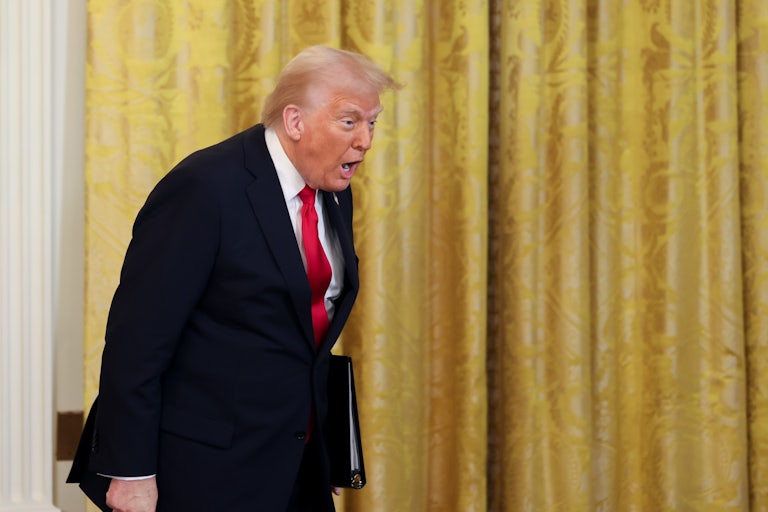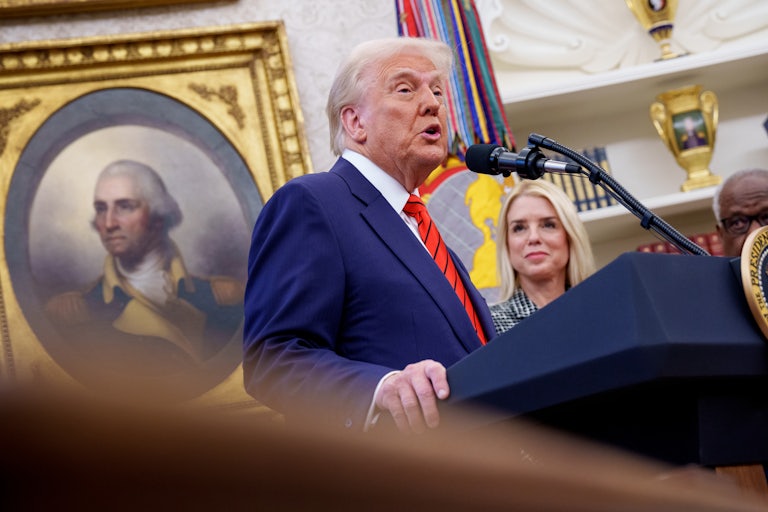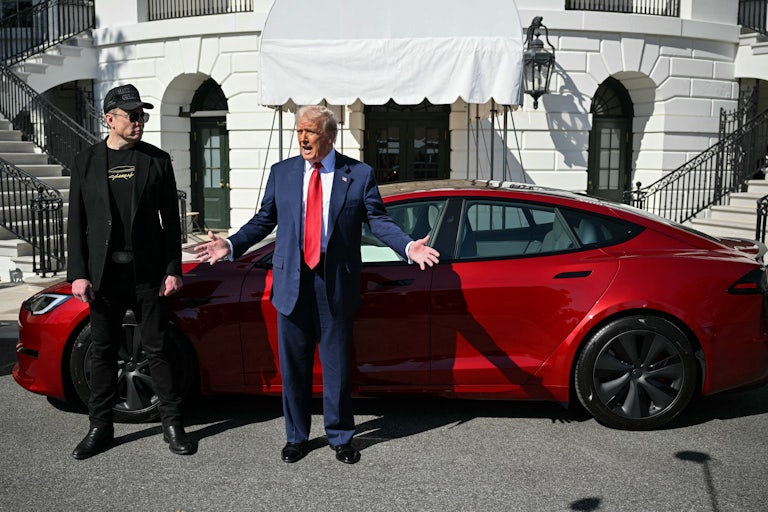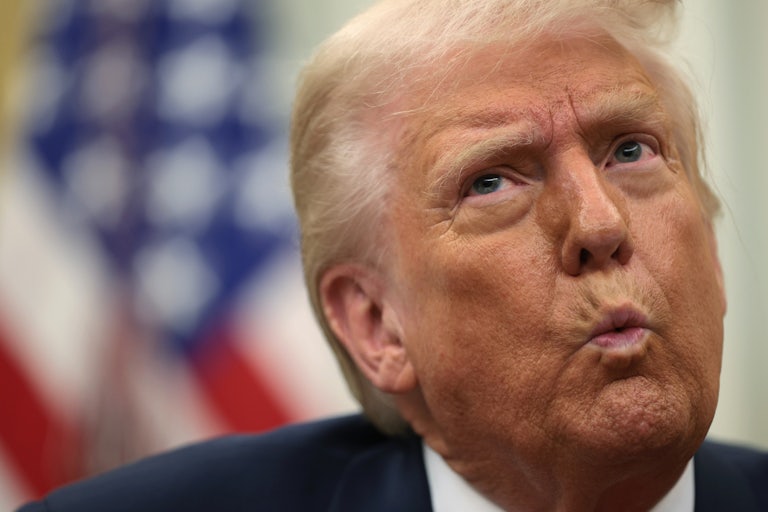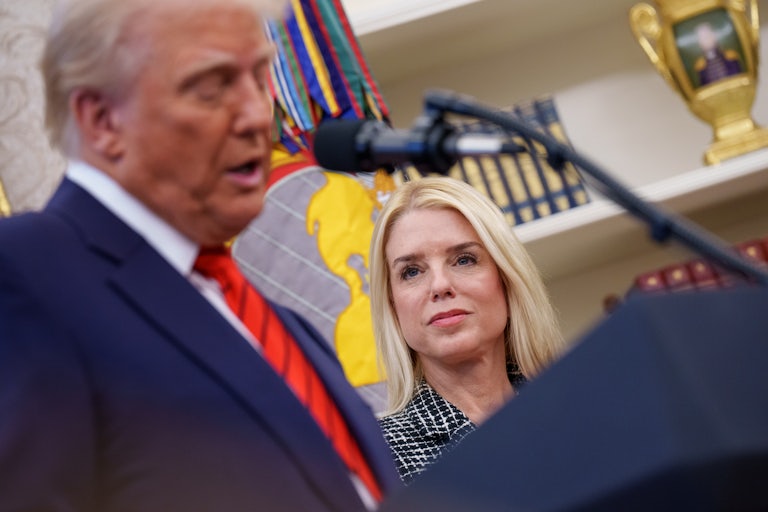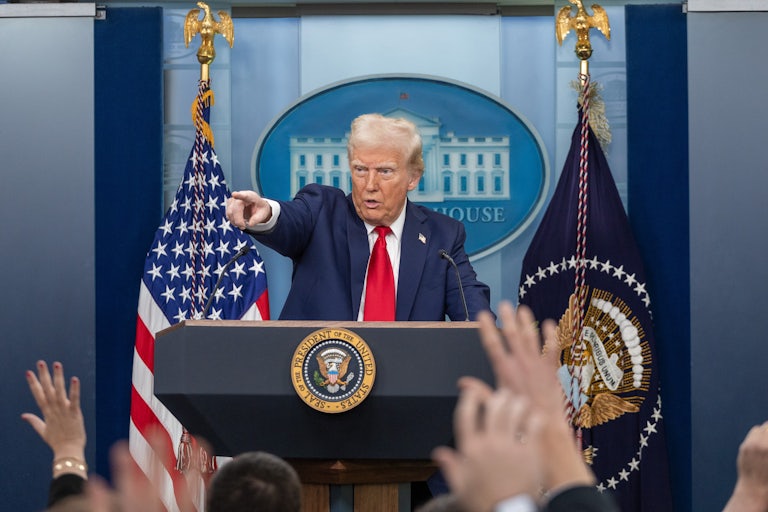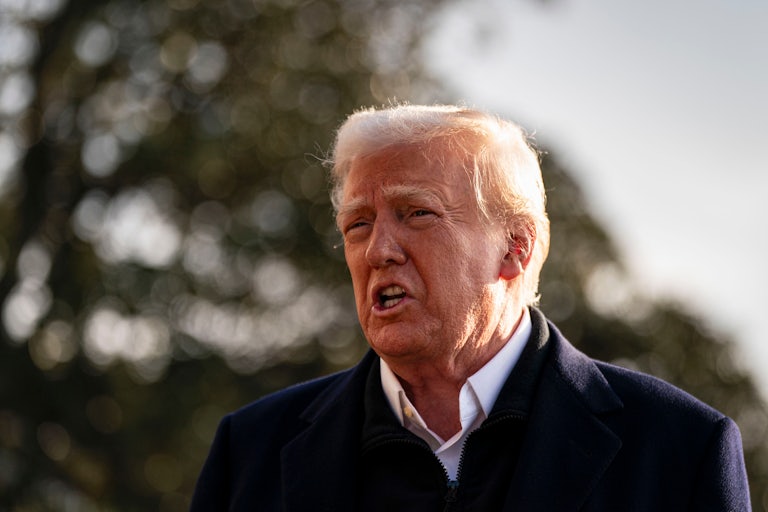Donald Trump Really Is a Lot Dumber Than We Thought. Like, a Lot!
His reading of American history is shockingly stupid, even for him.
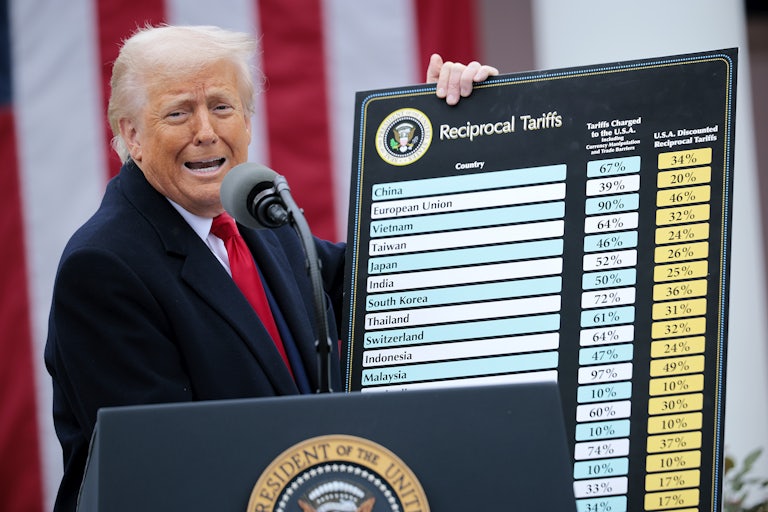
You remember the Brady Bunch movies of the 1990s, whose ingenious conceit was that television’s archetypal late-1960s sitcom family was transported to the ’90s but still lived in their oblivious 1969 bubble of bell bottoms and groovy chicks and Davy Jones fandom? That’s how I’ve been thinking of Donald Trump this week, except that he’s living in an 1890s bubble that no one around him is willing to puncture but that everyone else in the world, probably including those now-famous penguins on that one island, knows is utterly insane.
There’s a lot to say about these tariffs and how destructive they are, and most of it has been said. My colleague Timothy Noah wrote about the stupidity of tariffs as policy and how Trump has already cost him personally thousands of dollars. But I want to focus on something different here. I want to focus on Trump’s understanding of history. It’s so shockingly dumb—yes, even for him—that it’s hard to believe that we have a president of the United States who is this ignorant.
Here’s what Trump said the other day, and he has said versions of it a number of times: “In the 1880s, they established a commission to decide what they were going to do with the vast sums of money they were collecting. We were collecting so much money so fast, we didn’t know what to do with it. Isn’t that a nice problem to have?”
OK. First of all. Nobody can tell what commission he’s talking about. President Chester Arthur empaneled a commission that recommended reducing tariffs by 20 to 25 percent, going hard against the conventional wisdom of the day. But Congress defied him, lowering tariffs by just an average of around 1.5 percent (and yes, that’s another thing—Congress is supposed to set tariffs, not the president, making this move, among other things, an impeachment-worthy “abuse of power,” a phrase invoked by The Wall Street Journal editorial board Thursday).
But more importantly, there’s this. Allow me to put this as Trump himself might on Truth Social: THE MAN IS AN IDIOT!!!
It is true that tariffs were the chief source of federal government revenue for most of the country’s history until the twentieth century. Tariffs and excise taxes, which are taxes on specific goods—gasoline, cigarettes, alcohol, certain amusement activities. And for a spell, a modest income tax, which President Lincoln imposed during the Civil War and that lasted through 1872. But broadly speaking, tariffs were the ball game.
Even so, they were always a political hot potato because there were powerful interests that supported them (steel, iron, and wool) and other powerful interests that opposed them (wheat, cotton, tobacco). Tariffs were at the center of some of the most heated debates of the nineteenth century.
But here’s the thing you need to know that the president of the United States does not: Tariffs supported most of what the federal government did in the 1800s because the federal government didn’t do much of anything. The government did about four things. It recruited and paid an army. It delivered mail. It ran some courts of law. And it collected duties and tariffs. That was about it. There was no need for much federal revenue.
Today, liberals and conservatives argue over what might constitute an optimal number for federal spending as a percentage of gross domestic product. Generally speaking, liberals want that number to be up around 25 percent, which indicates a robust welfare state. Conservatives prefer that it be down closer to 15 or so.
Here are some numbers from the St. Louis Fed, which go back to the Great Depression. During the New Deal, as Roosevelt was just constructing the first iteration of the American welfare state, federal spending as a percentage of GDP got up to around 10 percent. During World War II, when the government took over a number of industries, it shot up to around 40 percent. In the postwar era, it has indeed hovered around 20, indicating the liberal-conservative tug of war over federal spending. Interestingly, it rose a little under Ronald Reagan (military spending), and it reached its highest postwar point, 30.7 percent, under … Donald Trump, during the pandemic.
So that is where federal spending as a percentage of GDP has been for nearly a century—17 percent, 22 percent, 30 percent in a crisis. Want to take a guess as to what it was in 1900? Maybe 11 percent? Nine percent? Seven? Try 2.7 percent.
In other words—tariffs could cover the cost of what the federal government did because the federal government didn’t do anything!
Now, there will of course be those who say, “Well, good! We need to go back to that!” OK. Let’s go back to no Social Security. Let’s go back to no Medicare. Let’s go back to senior citizens having to fend for themselves and move in with their kids (if you’ve never seen Make Way for Tomorrow, please watch it this weekend). Let’s go back to no environmental regulation, no food inspection. Let’s just have no airline safety regulations. Flying would be so much more interesting that way! And finally, I say to those conservatives who think they want a 1900-style government, let’s go back to an army of 25,000 personnel.
So in sum, Trump is fantasizing about some America that no one, literally not a single American, wants to return to. Poverty was through the roof. Health care was abysmal. People had seizures from toothaches. Most people didn’t even use toilet paper yet (it wasn’t “splinter-free” until the 1930s!).
One more idiotic Trump quote, if I may: “Then in 1913, for reasons unknown to mankind, they established the income tax so that citizens, rather than foreign countries, would start paying the money necessary to run our government.”
What?! Well, here, we encounter a very interesting history that maybe 1 percent of Americans know. As I noted, Lincoln imposed an income tax, which disappeared in 1872. There was no income tax for 20 years. Then there was a big depression in 1893, and Congress imposed a tax on high-income people for two years. Then it went away again.
Come the twentieth century and the Progressive era, and the demand for the government to do things like inspect meat and enforce child labor laws, and liberals began pushing for an income tax. Conservatives, of course, were opposed.
So in 1909, progressives attached an income tax plank to—guess what? A tariff bill. Conservatives counterproposed that an income tax be the subject of a constitutional amendment, confident that they’d fixed the progressives’ wagon because there was no way three-quarters of the states would approve such jackbooted madness. Then they sat and watched slack-jawed as state after state approved it! In 1913, the Sixteenth Amendment took effect.
Is it Trump’s secret plan to do away with the income tax? Actually, it’s not secret at all. He has said it many times. He’s going to raise $6 trillion from tariffs and abolish the IRS.
OK. We’ll see. Even putting aside the downsides of tariffs (most obviously, higher prices), economists see nothing close to $6 trillion in revenue.
Trump is blowing more smoke out his you-know-what than a decade of California wildfires could produce. Read this, from CBS.com: “In a recent news conference, White House staff secretary Will Sharf estimated that Mr. Trump’s 25 percent tariff on vehicles and auto parts imported into the U.S. could raise ‘roughly $100 billion in new revenue.’ At the same news conference, Mr. Trump claimed moments later ‘anywhere from $600 billion to $1 trillion will be taken in over the relatively short-term period, meaning a year from now.’”
The aide says $100 billion. Trump casually ups it to a trillion. Billion, trillion; who knows. Well, even I know: A trillion is a thousand billions. That’s like the difference between 10 and 10,000. Pretty vast, in other words. But Trump knows that nobody really thinks about the difference between a billion and a trillion, so just say a trillion.
Finally, before I let you go: How much do tariffs bring in now? Around $80 billion. Sounds like a lot, and it is. But take a guess as to how much total revenue the federal government takes in, from (1) income taxes, which is half of all revenue, (2) payroll taxes, (3) excise taxes, and (4) corporate taxes.
It’s around $4.7 trillion. Know what percentage of $4.7 trillion $80 billion is? About 1.7 percent. That’s how much of our current federal revenue comes from tariffs.
Going from 1.7 percent to 100 percent sounds, um, like something that will cause vast, unknowable dislocations; and more to the point, like the fantasy of a stupid man who’s never read a book and has no effing idea what he’s talking about.
Or as Gary Cole’s Mike Brady might have put it: “Donald, when you’re trying to fool other people, you’re really only fooling yourself, and who’s the real fool then?”
This article first appeared in Fighting Words, a weekly TNR newsletter authored by editor Michael Tomasky. Sign up here.
